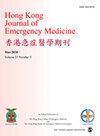Comparing accuracy of clinical prediction rules to predict pneumonia in children and adolescents with acute febrile respiratory illness
IF 0.8
4区 医学
Q4 EMERGENCY MEDICINE
引用次数: 0
Abstract
It is a common challenge for emergency physicians to differentiate pneumonia from simple upper respiratory tract infections. Several clinical prediction rules exist to assist the diagnosis process and guide the clinical decisions of ordering investigations such as chest X‐ray (CXR).This study aims to validate and compare the accuracy of various prediction rules in the setting of children and adolescents presenting with acute febrile respiratory illness (AFRI).This was a prospective multicentre study. Three hundred and fifty‐five patients, aged 6–18 years, were recruited. Patients with immunocompromised state or hypoxia were excluded. Pneumonia was defined as diagnosis by CXR or subsequent diagnosis of pneumonia upon re‐attendance within 7 days. Clinical rules including Diehr rule, Heckerling rule, Bilkis simpler rule, the AFRI rule, the paediatric acute febrile respiratory illness rule (PAFRI) were compared in terms of accuracy of predicting pneumonia in the recruited subjects and presented as receiver operating characteristic curves.Five patients were excluded. In the 350 patients included, 38 were diagnosed as pneumonia by CXR and 1 was subsequently diagnosed as pneumonia upon re‐attendance. The area under the receiver operating characteristic curve of Diehr rule, Heckerling rule, Bilkis simpler rule, AFRI rule and PAFRI rule were 0.703, 0.565, 0.59, 0.807 and 0.846 respectively. The PAFRI rule is superior to other prediction rules in terms of diagnostic accuracy. At the cut‐off of PAFRI ≥0, the rule has high sensitivity of 97.44% and negative predictive value of 99.09%.Among the rules compared, the PAFRI rule has the highest diagnostic accuracy in assisting emergency physicians to identify pneumonia among children and adolescents aged 6–18 years presenting with AFRI.比较临床预测规则预测儿童和青少年急性发热呼吸道疾病肺炎的准确性
如何区分肺炎和单纯上呼吸道感染是急诊医生面临的共同挑战。本研究旨在验证和比较各种预测规则在儿童和青少年急性发热性呼吸道疾病(AFRI)中的准确性。研究招募了 355 名 6-18 岁的患者。免疫力低下或缺氧的患者被排除在外。肺炎的定义是通过气管造影确诊或在 7 天内再次就诊时被诊断为肺炎。临床规则包括 Diehr 规则、Heckerling 规则、Bilkis 简易规则、AFRI 规则、儿科急性发热呼吸道疾病规则 (PAFRI)。在纳入的 350 名患者中,38 人经 CXR 诊断为肺炎,1 人随后在再次就诊时被诊断为肺炎。Diehr规则、Heckerling规则、Bilkis简化规则、AFRI规则和PAFRI规则的接收者操作特征曲线下面积分别为0.703、0.565、0.59、0.807和0.846。就诊断准确性而言,PAFRI 规则优于其他预测规则。在所比较的规则中,PAFRI 规则在协助急诊医生识别 6-18 岁儿童和青少年 AFRI 患者的肺炎方面具有最高的诊断准确性。
本文章由计算机程序翻译,如有差异,请以英文原文为准。
求助全文
约1分钟内获得全文
求助全文
来源期刊

Hong Kong Journal of Emergency Medicine
EMERGENCY MEDICINE-
CiteScore
1.50
自引率
16.70%
发文量
26
审稿时长
6-12 weeks
期刊介绍:
The Hong Kong Journal of Emergency Medicine is a peer-reviewed, open access journal which focusses on all aspects of clinical practice and emergency medicine research in the hospital and pre-hospital setting.
文献相关原料
| 公司名称 | 产品信息 | 采购帮参考价格 |
|---|
 求助内容:
求助内容: 应助结果提醒方式:
应助结果提醒方式:


